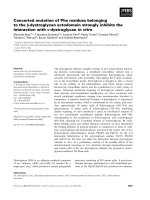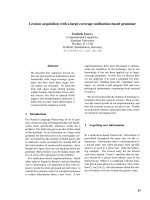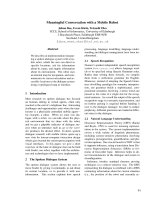FUN WITH A PENCIL pot
Bạn đang xem bản rút gọn của tài liệu. Xem và tải ngay bản đầy đủ của tài liệu tại đây (11.03 MB, 122 trang )
1
2
FUN WITH A PENCIL
ALSO BY ANDREW LOOMIS
Figure Drawing for All It’s Worth
Creative Illustration
Drawing the Head and Hands
Three-Dimensional Drawing
3
Spacer
4
FUN
WITH A PENCIL
ANDREW LOOMIS
5
COPYRIGHT 1939 BY ANDREW LOOMIS
FIRST PUBLISHED BY THE VIKING PRESS IN MAY 1939
BY THE MACMILLAN COMPANY OF CANADA LIMITED
REPRODUCED FOR EDUCATIONAL USE IN DECEMBER 2001
All drawings and text within this book are the property of
their respective copyholders and should not be reproduced
for any reason. They may only be used for the
purpose of practice and study.
6
DEDICATED TO EVERYONE WHO LOVES A PENCIL
7
MR. WEBSTER DEFINES DRAWING
AS DELINEATION. THAT DOESN’T
TELL YOU HOW MUCH OF A REAL
“BANG” THERE IS IN IT. MAYBE
HE NEVER KNEW. MOST FOLKS
LOVE TO DRAW EVEN WHEN
THEY KNOW LITTLE ABOUT IT. IT
STARTED WITH THE CAVE MAN,
AND STILL SURVIVES ON THE
WALLS OF PUBLIC PLACES BE-
CAUSE IT’S SO MUCH FUN, AND
SO EASY, IT’S A SHAME NOT TO BE
ABLE TO DO IT BETTER.
ANDREW LOOMIS
8
ALL THAT YOU NEED TO KNOW, TO START
THIS BOOK, IS HOW TO DRAW A CIRCLE. . . .
Don’t start out with that old gag, “I couldn’t draw a straight
line.” Neither can I, freehand. If we need a straight line, we
can use a ruler. Now please try it, just for fun.
And it can be as lopsided as the family budget, and
still work out.
9
HOWDY
FOLKS!
Who am I? Oh, just one of Andy’s little funny folk.
But I’m important! He gave me a job. I’m the spirit
of the book, by jeeminy, big nose and all. I represent
all the blue in here. My right name would be Basic
Form, but that’s much too high-sounding. He thinks
that name would scare you away. So he just calls me
"Professor Blook’’ and lets it go at that. Now, I’ve got
a few interesting things to tell you.
10
Since Andy cannot talk to you personally, he put me in
here so we can really get together. It’s tough on Andy,
for that guy really loves to talk, especially "shop talk.’’
Now this plan of action is based on the use of simple
forms that are already known and familiar to you, and
which you can certainly draw.
From these simple, known forms, we build other
forms, which without some constructive plan would
be too complicated to draw. For instance, the top of
the head, or cranium, is nearer to a ball in shape
than anything else. So we start with a bull, and add
to it the shapes we want. We thus "arrive’’ at the out-
lines that are needed instead of guessing at them. Only
the most talented end experienced artist can draw at
once the final outlines. That procedure is most diffi-
cult, and is the reason most people give up drawing.
But knowing how to "construct’’ makes drawing simple
and easy, and a delightful pastime to anybody. By build-
ing preliminary shapes and developing the outlines on
them, we know WHERE TO DRAW OUR REAL
LINES. There is hardly anything that cannot first be
constructed by the use of simple forms.
“Santa had a belly, like a bowl full of jelly.’’ Now that
was a real observation. We know just whet it must hove
looked like. In fact we can see it shaking! Now, the idea
is to draw the bowl before the belly. If the observation
is correct, it ought to be a simple matter to make it fairly
convincing as an abdomen for old Nick. Of course we
will cover it with his coat and pants, but we’ll be pretty
sure the pants don’t spoil the big idea. I
picked on Santa because he’ll never complain that I’m
being too personal over his appearance. I might just
as well have chosen your next-door neighbor, his lunch
basket may be equally rotund, and shake some too.
Every form is like some simpler form, with this or that
variation, and with pieces added on. The simplest
11
Forms we know are the sphere, the cube, and the egg.
Before we could walk we recognized the sphere in
Dad’s new golf bulls; the cubes were in the sugar bowl;
as for the eggs, well, the nicest ones were Easter eggs.
I say, “Draw a line.’’ You cannot know just what I
mean. A straight line? A curved line? A jagged line? A
wiggly line? There are a thousand kinds of lines; be
more specific. But it I say draw a ball, a cube, an egg,
a cylinder, a pyramid, a cone, a rectangular block, in
each case the image you get is perfect. You know ex-
actly what I mean. Instead of “line,’’ we shall think in
terms of concrete and tangible “form,’’ and proceed
as if we were handling lumps of clay. You can appreci-
ate the value of such a method, for you know the fun-
damentals even before you start; they are obvious to
anybody. If you never saw a ball, you should quit right
now.
As you proceed to build all sorts of shapes out of
simpler ones, it is amazing what you can do with
them, and how accurate and "solid’’ the resulting draw-
ings will appear. The surprising part is that, when the
construction lines are erased, very few could guess how
it had been done. Your drawing appears us complicated
and difficult to the other fellow as mine might seem to
you now. It takes on a look of professional workman-
ship, which indeed it has, since the professional artist
has by some method had to “construct’’ his work to
make it “professional.’’
If you will give the following pages even your amused
attention, I am satisfied you will find much that will
surprise you in the way of ability but perhaps you here-
tofore never guessed you had. If it absorbs your inter-
est, you might find yourself clever enough to amaze
those about you. Just now take my word for it that the
method is simple, practical, and, I believe, possible for
anybody to follow.
12
TAKE A GOOD LOOK AT THIS PAGE
A circle is a flat disk. If you draw the “inside” contours, it
becomes a solid ball, with a third dimension. We shall
build other forms, like lumps of clay, onto this solidity.
The construction will be erased, but the solid appearance
will remain, giving form or the appearance of reality.
13
Get a pencil and paper quickly! Draw lightly all you see printed in
blue. Take one stage at a time, on one drawing, until the last stage;
then finish, with strong lines over the light ones, the lines we have
printed in black. That is all there is to learn! These are "selected’’ or
"built in’’ from the basic forms. I call the basic drawings “Blooks,’’
after myself .
PART ONE HOW TO DRAW FUNNY FACES
14
HERE WE GO!
I promised you that all you need to know, to start this book, is how to draw a
lopsided ball. Whatever shape you draw can be used as a foundation for a funny
face. Do the best you can, even if the ball looks more like a potato.
15
THE FUN STARTS!
The big idea is to start with a “form.” Then develop other “forms”
on it. Build your final lines in by selecting, eliminating the lines
you do not use. I leave mine in to show how it’s done.
16
A SURE METHOD FOR ANYBODY
17
IT’S REALLY GOING TO BE EASIER THAN YOU EXPECTED
Now, if the first drawings you do are not the last word in cleverness, don’t be
discouraged. You will soon get the idea. When you begin to sense form, you
will have the whole works. Then we’ll polish up, and they will have to admit
you are good.
18
THE “BLOOK BALL”
If you will now turn back to page 12 and look at the string of balls, you will see
that we are getting right into big business. You need some practice on these.
Never mind if they are a little off.
The better you can draw these balls in any old position you wish, the better you
are going to be. The line from the top to bottom is the “middle” line of the face.
The horizontal line, which looks like the equator, is the “eyeline,” and it also
locates the ear.
19
JUST PRACTICE ON THESE “BLOOKS”
20
THE BEST WAY TO GO ABOUT IT
21
WE ADD ANOTHER LINE TO THE BALL
Look at the diagram. This last line goes completely
around the ball, thought the axis at each end, and cuts
the eyeline just halfway round on each side of the middle
line. The ear joins the head at the point of intersection of
the eyeline and the earline.
22
THERE IS NO LIMIT TO THE VARIETY
I am a lot more anxious to have you understand the method and
create your own forms than to copy mine. But copying mine
now will get you started.
Always construct the head from the cranium down. There is no
other satisfactory way. You can see by now that the position of
the ball determines the pose of the head. The pieces you build
on determine the character.
23
“BLOCKY” TREATMENT LENDS CHARACTER
“Blocky” shapes always combine interestingly with round shapes.
It is a good idea to make the final lines angular even around curves.
It gives a sense of bone and ruggedness of character. You would
not do this when drawing pretty girls or babies.
Now I’ve got a surprise for you. Instead of drawing all there
lunkheads, let’s try something real. I’m going to pose for you.
24
BLOOK POSES
25
EXPRESSION









